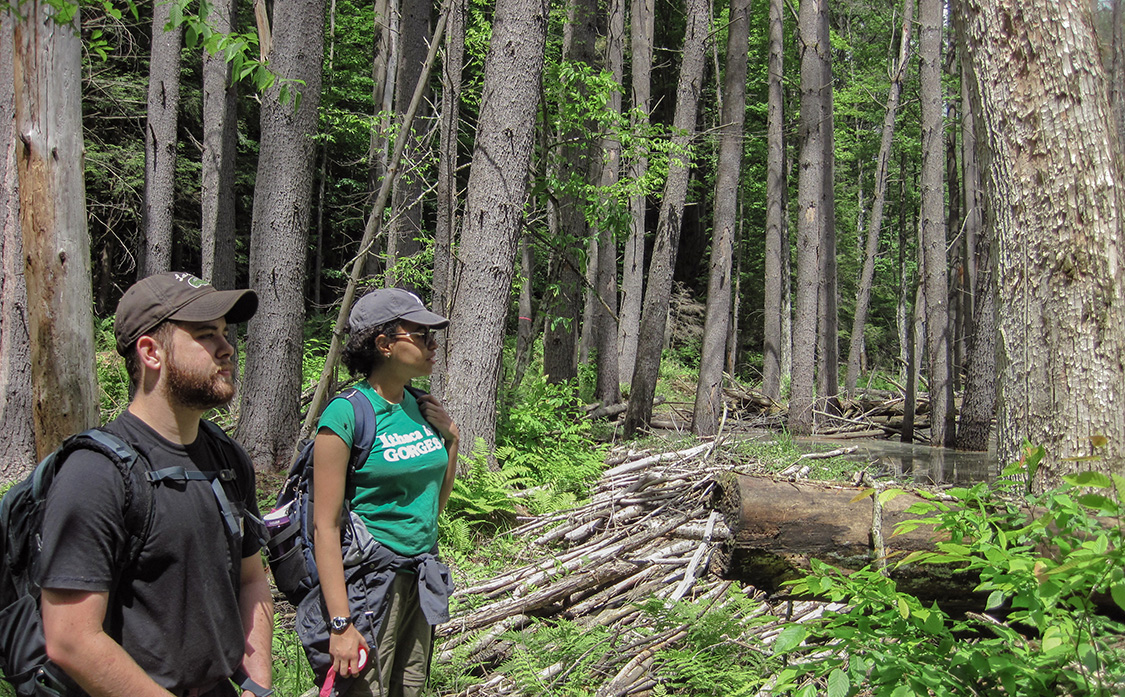Parasites, snails may factor in Adirondack moose decline
By Blaine Friedlander

The apparent declining moose population in New York ’s Adirondack Mountains may be caused partly by tiny parasite-transmitting snails eaten by moose as they forage vegetation, according to new research presented by two Cornell undergraduate students at the annual Ecological Society of America meeting, in Portland, Oregon, Aug. 8.
“Our results show that moose foraging in areas with high soil moisture may likely encounter higher densities of gastropods – snails and slugs – which likely increases the risk of parasitic threats from deer brain worm if the snails are eaten,” said Jailene Hidalgo ’18. Soil moisture had a strong effect on snail abundance, while variables such as soil pH, soil temperature and habitat type made little difference.
Said Hidalgo: “Since moose make use of water areas and eat in wet, dense pine forests, they’re susceptible to a large presence of gastropods that pose a greater risk of Parelaphostrongylus tenuistransmission when white-tailed deer occupy the same space.”
Hidalgo and Carlos Fernandez ’19 work in the laboratory of Angela Fuller, associate professor of natural resources, and leader of the New York Cooperative Fish and Wildlife Research Unit.
After being absent for more than a century, moose returned to the Adirondacks in the 1980s. The New York Wildlife Health Program – in which the Wildlife Health Lab at Cornell’s College of Veterinary Medicine participates – conducted surveys in 2016 on 11 live moose and 22 necropsies and concluded parasites are a major threat to the moose population. As of 2010, New York state wildlife biologists had put the Adirondack moose population at 800.
Moose populations in nearby states such as New Hampshire are declining, leading scientists in New York to investigate the apparent decline in the Adirondacks. Last spring Fuller and her colleagues published New York moose occupancy estimates through hunter surveys. Fuller and other researchers in New York are currently studying the population size of moose and aim to monitor the animals through time.
Deer and snails both host the parasite, but they themselves are unaffected by it, Hidalgo said. The parasites’ eggs hatch in a deer’s brain, travel through its respiratory system to the gastrointestinal tract, finally exiting through feces as worm larvae. Snails feed on the mucus membrane of the worm larvae. Foraging moose then ingest infected snails, culminating in a diseased brain and spinal cord, and occasionally death. New York wildlife pathologists have confirmed cases.
On the same project, Fernandez sought to understand the best snail and slug trapping methods to assess parasitic threats. In addition to visual tree searches, three different trap types were set up and tested: pitfall ground traps, cardboard ground traps and water bottle tree traps.
Cardboard ground traps captured three times as many snails and slugs than did the ground pitfall traps. Statistically, there was no significant difference in capture rates between the bottle traps and visual searches. “Understanding the snail population can lead to improved abundance estimates, which can be used to further assess the health of the moose population in New York,” Fernandez said.
Hidalgo’s poster, “Environmental Factors Influencing Gastropod Abundance: Implications of Parelaphostrongylus tenuis for Moose in the Adirondacks,” will be exhibited, as will Fernandez’s poster, “Gastropod Sampling Methodologies for Assessing Parasitic Threats to Moose in the Adirondacks.”
Hildalgo was inducted last spring into the Ronald E. McNair Post-Baccalaureate Achievement Program. Fernandez and Hidalgo take part in Cornell’s Doris Duke Conservation Scholars program.
Media Contact
Get Cornell news delivered right to your inbox.
Subscribe